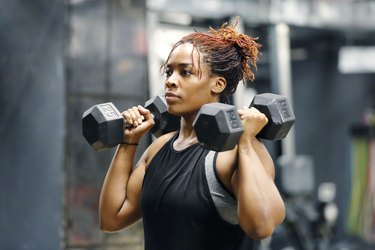
Veins bulging from your body often look large, rigid and under high pressure. Many people assume this is the circulatory system's response to heightened demands resulting from exercise. Although exercise does have effects in the body that can change the appearance of your veins and arteries, it is not a matter of new ones appearing or old ones enduring more stress.
In fact, the appearance of veins under your skin when weightlifting has very little to do with the veins at all.
Video of the Day
Video of the Day
Tip
You don't actually get more veins after lifting weights. The ones you have are flattened from the swelling of the muscle and just appear to bulge.
Effects of Exercise
Any type of exercise elevates the heart rate to some degree. This is a physiological response to an increased need for oxygen in the body, particularly in locations where work is being performed. The heart rate and breathing rate increase to compensate for the increased work, which is fueled through blood flow to exercised locations, such as the muscles.
According to Harvard Health Publishing, exercise also fights off conditions such as hypertension, some cancers and heart disease. It also protects bones that weaken as you age through the loss of calcium.
Role of Plasma
The changes in the appearance of your veins actually have little to do with what occurs in the veins themselves, according to Scientific American. In fact, these effects in your veins are the product of changes in the muscle matter surrounding them.
The body's plasma flows into muscles during exercise and causes them to swell and harden. The hardening of muscle pushes inset venous tissue to the surface of the muscles and against the skin, making it more visible, while the function of the veins remains largely unchanged. ExRx.net says that the "pumped" effect lasts only 15 to 30 minutes.
Volume and Pressure Myth
The long-held belief of the cause of bulging veins was that exercise forced the heart and circulatory system to distribute blood faster, leading to an increase of volume and pressure in the veins that pushed out venous walls and made them more rigid.
However, a more recent study of bulging veins has shown that pressure actually declines during exercise because circulation is improved throughout the body, distributing blood and putting less pressure on any one passageway. Volume also remains constant throughout the body and can increase in smaller capillaries while decreasing in larger vessels.
Read more: Advantages and Disadvantages of Exercise
Think About This
Although bulging veins are a common byproduct of exercise, you can also develop more prominent veins through potential hazardous health concerns. Deep vein thrombosis can contribute to bulging veins, which could be a precursor to a blood clot, says Harvard Health Publishing.
Smoking also accentuates veins on the surface of the skin, as does excessive stress. Older individuals are more likely to develop bulging veins for this reason. If you are unsure about the cause of your bulging veins, call or visit a doctor.
- Scientific American: "Why Do Veins Pop Out When Exercising, and Is That Good or Bad?"
- ACE Fitness: "Five Reasons You Shouldn’t Skip Your Cool-Down After Exercise"
- ExRx.net: "Pump and Burn"
- Harvard Health Publishing: "The Secret to Better Health - Exercise"
- Harvard Health Publishing: "Varicose Veins: Clues to a Deeper Problem?"